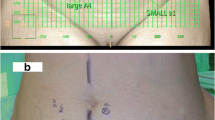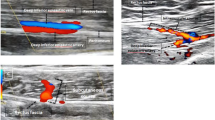Abstract
Purpose
Matching the diameter of the deep inferior epigastric artery (DIEA) and perforating branch (PB) of the internal thoracic artery (ITA) is important for arterial anastomosis during breast reconstruction using the DIEA flap. An anatomic investigation of these arteries was performed using multidetector row computed tomography (MDCT).
Patients and methods
Contrast-enhanced MDCT data of 50 women (aged 18–90 years) covering the neck to the groin were analyzed. The diameter of the PBs of the ITA at their origins from the first to the sixth intercostal space and of the DIEA 20 mm from the bifurcation of the external iliac artery were measured.
Results
The mean diameters of the right and left DIEAs were 1.53 ± 0.263 mm and 1.53 ± 0.306 mm, respectively. The diameter of the PBs in the second and third intercoastal spaces was the same as the diameter of the DIEA, bilaterally.
Conclusion
It is suggested that anastomosis of the DIEA with PBs of the ITA in the second and third intercoastal spaces is optimal for DIEA flap grafting. Our results could contribute to making vascular anastomosis easier, thereby reducing the burden on both surgeons and patients.




Similar content being viewed by others
References
Cancer statistics. Japan: Cancer Information Service, National Cancer Center (National Cancer Registry, Ministry of Health, Labour and Welfare)
Shimoi T, Nagai SE, Yoshinami T, Takahashi M, Arioka H, Ishihara M, et al. The Japanese Breast Cancer Society Clinical Practice Guidelines for systemic treatment of breast cancer, 2018 edition. Breast Cancer. 2020;27:322–31.
Kaya B, Serel S. Breast reconstruction. Exp Oncol. 2013;35:280–6.
Blondeel PN, Morrison CM, Allen RJ. The deep inferior epigastric artery perforator (DIEAP) flap. In: Nahabedian MY, Neligan PC, Liu DZ, editors. Plastic surgery, 5: breast. 4th ed. New York: Elsevier; 2018. p. 323–42.
Granzow JW, Levine JL, Chiu ES, Allen RJ. Breast reconstruction using perforator flaps. J Surg Oncol. 2006;94:441–54.
Nergård S, Mercer JB, de Weerd L. Internal mammary vessels’ impact on abdominal skin perfusion in free abdominal flap breast reconstruction. Plast Reconstr Surg Glob Open. 2017;5:e1601.
Fansa H, Schirmer S, Cervelli A, Gehl HB. Computed tomographic angiography imaging and clinical implications of internal mammary artery perforator vessels as recipient vessels in autologous breast reconstruction. Ann Plast Surg. 2013;71:533–7.
Cho MJ, Haddock NT, Gassman AA, Teotia SS. Use of composite arterial and venous grafts in microsurgical breast reconstruction: technical challenges and lessons learned. Plast Reconstr Surg. 2018;142:867–70.
Schmidt M, Aszmann OC, Beck H, Frey M. The anatomic basis of the internal mammary artery perforator flap: a cadaver study. J Plast Reconstr Aesthet Surg. 2010;63:191–6.
Mosahebi A, Da Lio A, Mehrara BJ. The use of a pectoralis major flap to improve internal mammary vessels exposure and reduce contour deformity in microvascular free flap breast reconstruction. Ann Plast Surg. 2008;61:30–4.
Kim DH, Kim CW, Lee JW, Kim U, Jung S, Hwang E. Distribution of internal thoracic artery perforators: a clinical anatomy study. Clin Anat. 2019;32:471–5.
Bertelli JA, Khoury W, do Vale Pereira YF. Contribution of the internal thoracic artery perforating system in breast supply: anatomic basis of a new technique for breast reconstruction using the opposite breast. Surg Radiol Anat. 1991;13:347–8.
de Heer EC, Jalving M, Harris AL. HIFs, angiogenesis, and metabolism: elusive enemies in breast cancer. J Clin Invest. 2020;130:5074–87.
Zhang Q, Lu S, Li T, Yu L, Zhang Y, Zeng H, et al. ACE2 inhibits breast cancer angiogenesis via suppressing the VEGFa/VEGFR2/ERK pathway. J Exp Clin Cancer Res. 2019;38:173.
Schoenhagen P, Zimmermann M, Falkner J. Advanced 3-D analysis, client–server systems, and cloud computing-Integration of cardiovascular imaging data into clinical workflows of transcatheter aortic valve replacement. Cardiovasc Diagn Ther. 2013;3:80–92.
Blondeel PN. One hundred free DIEP flap breast reconstructions: a personal experience. Br J Plast Surg. 1999;52:104–11.
Hamdi M, Weiler-Mithoff EM, Webster MH. Deep inferior epigastric perforator flap in breast reconstruction: experience with the first 50 flaps. Plast Reconstr Surg. 1999;103:86–95.
Chen CK, Tai HC, Chien HF, Chen YB. Various modifications to internal mammary vessel anastomosis in breast reconstruction with deep inferior epigastric perforator flap. J Reconstr Microsurg. 2010;26:219–23.
Nakatani K, Maeda H, Tanaka Y, Hamada N, Nishioka A, Sasaguri S, et al. Perforating branches of the internal thoracic artery in women with breast cancer: an anatomical study for breast-conservation surgery. Oncol Rep. 2008;19:1299–303.
Peeters WJ, Nanhekhan L, Van Ongeval CV, Fabré G, Vandevoort M. Fat necrosis in deep inferior epigastric perforator flaps: an ultrasound-based review of 202 cases. Plast Reconstr Surg. 2009;124:1754–8.
Masia J, Larrañaga J, Clavero JA, Vives L, Pons G, Pons JM. The value of the multidetector row computed tomography for the preoperative planning of deep inferior epigastric artery perforator flap: our experience in 162 cases. Ann Plast Surg. 2008;60:29–36.
Ohjimi H, Era K, Fujita T, Tanaka T, Yabuuchi R. Analyzing the vascular architecture of the free TRAM flap using intraoperative ex vivo angiography. Plast Reconstr Surg. 2005;116:106–13.
González Martínez J, Torres Pérez A, Gijón Vega M, Nuñez-Villaveiran T. Preoperative vascular planning of free flaps: comparative study of computed tomographic angiography, color doppler ultrasonography, and hand-held doppler. Plast Reconstr Surg. 2020;146:227–37.
Giunta RE, Geisweid A, Feller AM. The value of preoperative Doppler sonography for planning free perforator flaps. Plast Reconstr Surg. 2000;105:2381–6.
Smit JM, Dimopoulou A, Liss AG, Zeebregts CJ, Kildal M, Whitaker IS, et al. Preoperative CT angiography reduces surgery time in perforator flap reconstruction. J Plast Reconstr Aesthet Surg. 2009;62:1112–7.
Levin DC, Parker L, Halpern EJ, Rao VM. Coronary CT angiography: use in patients with chest pain presenting to emergency departments. AJR Am J Roentgenol. 2018;210:816–20.
Uppal RS, Casaer B, Van Landuyt KV, Blondeel P. The efficacy of preoperative mapping of perforators in reducing operative times and complications in perforator flap breast reconstruction. J Plast Reconstr Aesthet Surg. 2009;62:859–64.
Funding
We did not receive any funding for the study.
Author information
Authors and Affiliations
Corresponding author
Ethics declarations
Conflict of interest
All authors have no conflicts of interest to declare.
Ethical statement
This retrospective study was conducted in accordance with the tenets of the amended Declaration of Helsinki and with the approval of the institutional review board of St. Marianna University School of Medicine (No. 2018090424019). Patient anonymity was preserved, and the need for informed consent was waived due to the retrospective nature of the study.
Additional information
Publisher's Note
Springer Nature remains neutral with regard to jurisdictional claims in published maps and institutional affiliations.
About this article
Cite this article
Komemushi, T., Okuda, I., Komemushi, A. et al. Matching the perforating branch of the internal thoracic artery and the deep inferior epigastric artery for breast reconstruction using multi-detector row computed tomography. Jpn J Radiol 40, 624–629 (2022). https://doi.org/10.1007/s11604-021-01235-0
Received:
Accepted:
Published:
Issue Date:
DOI: https://doi.org/10.1007/s11604-021-01235-0




